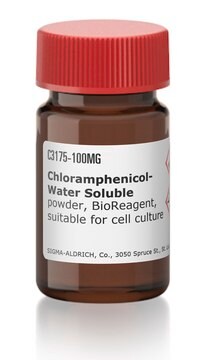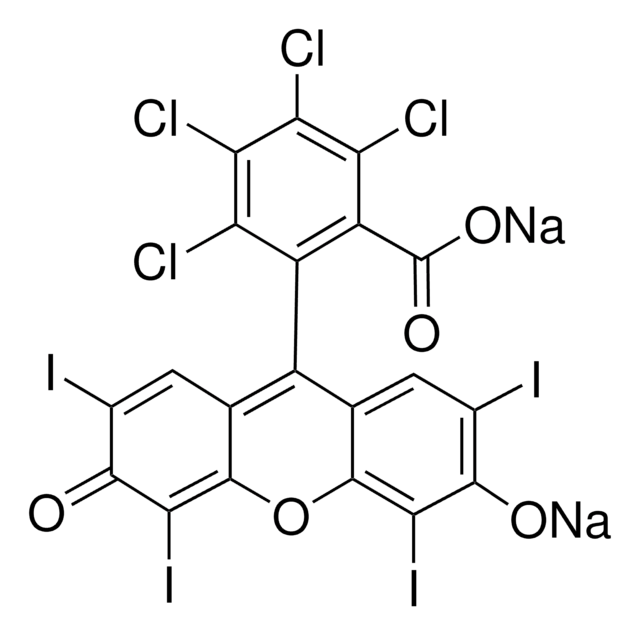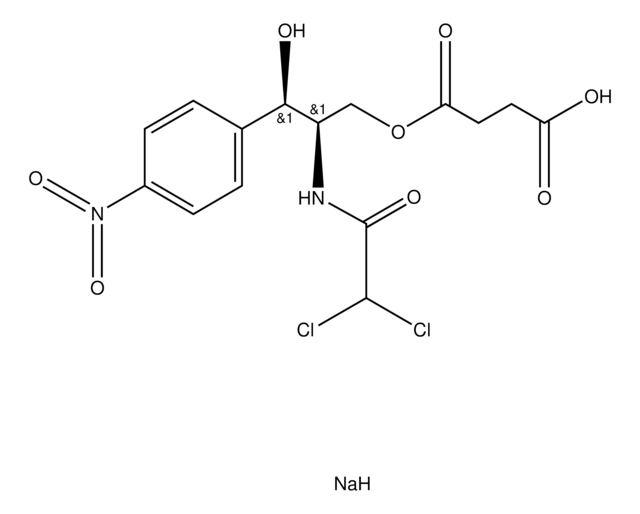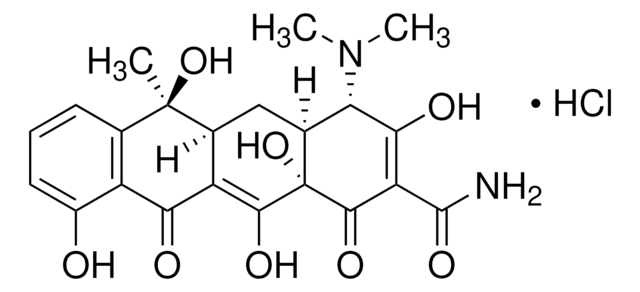Wichtige Dokumente
C1919
Chloramphenicol
BioReagent, suitable for plant cell culture
Synonym(e):
D(−)-threo-2,2-Dichlor-N-[β-hydroxy-α-(hydroxymethyl)-β-(4-nitrophenyl)-ethyl]-acetamid, D-(−)-threo-2-Dichloracetamido-1-(4-nitrophenyl)-1,3-propandiol, D-threo-2,2-Dichlor-N-[β-hydroxy-α-(hydroxymethyl)-4-nitrophenethyl]-acetamid, Chloromycetin
About This Item
Empfohlene Produkte
Produktlinie
BioReagent
Qualitätsniveau
Form
powder
Methode(n)
cell culture | plant: suitable
Verunreinigungen
Endotoxin, tested
mp (Schmelzpunkt)
149-153 °C (lit.)
Wirkungsspektrum von Antibiotika
Gram-negative bacteria
Gram-positive bacteria
mycobacteria
mycoplasma
Anwendung(en)
agriculture
Wirkungsweise
protein synthesis | interferes
Lagertemp.
2-8°C
SMILES String
OC[C@@H](NC(=O)C(Cl)Cl)[C@H](O)c1ccc(cc1)[N+]([O-])=O
InChI
1S/C11H12Cl2N2O5/c12-10(13)11(18)14-8(5-16)9(17)6-1-3-7(4-2-6)15(19)20/h1-4,8-10,16-17H,5H2,(H,14,18)/t8-,9-/m1/s1
InChIKey
WIIZWVCIJKGZOK-RKDXNWHRSA-N
Angaben zum Gen
human ... CYP1A2(1544)
Suchen Sie nach ähnlichen Produkten? Aufrufen Leitfaden zum Produktvergleich
Allgemeine Beschreibung
Anwendung
Biochem./physiol. Wirkung
Resistenzmechanismus: Die Verwendung von Chloramphenicol-Acetyltransferase führt zur Acetylierung und Inaktivierung des Produkts.
Antimikrobielles Spektrum: Es handelt sich um ein Breitbandantibiotikum gegen grampositive und gramnegative Bakterien, das vor allem in der Augenheilkunde und in der Tiermedizin eingesetzt wird.
Vorsicht
Angaben zur Herstellung
Sonstige Hinweise
Signalwort
Danger
H-Sätze
Gefahreneinstufungen
Carc. 2 - Eye Dam. 1 - Repr. 2
Lagerklassenschlüssel
11 - Combustible Solids
WGK
WGK 3
Persönliche Schutzausrüstung
Eyeshields, Gloves, type P3 (EN 143) respirator cartridges
Hier finden Sie alle aktuellen Versionen:
Analysenzertifikate (COA)
Die passende Version wird nicht angezeigt?
Wenn Sie eine bestimmte Version benötigen, können Sie anhand der Lot- oder Chargennummer nach einem spezifischen Zertifikat suchen.
Besitzen Sie dieses Produkt bereits?
In der Dokumentenbibliothek finden Sie die Dokumentation zu den Produkten, die Sie kürzlich erworben haben.
Kunden haben sich ebenfalls angesehen
Artikel
Antibiotic kill curve is a dose response experiment in which mammalian cells are subjected to increasing amounts of selection antibiotic
Unser Team von Wissenschaftlern verfügt über Erfahrung in allen Forschungsbereichen einschließlich Life Science, Materialwissenschaften, chemischer Synthese, Chromatographie, Analytik und vielen mehr..
Setzen Sie sich mit dem technischen Dienst in Verbindung.










